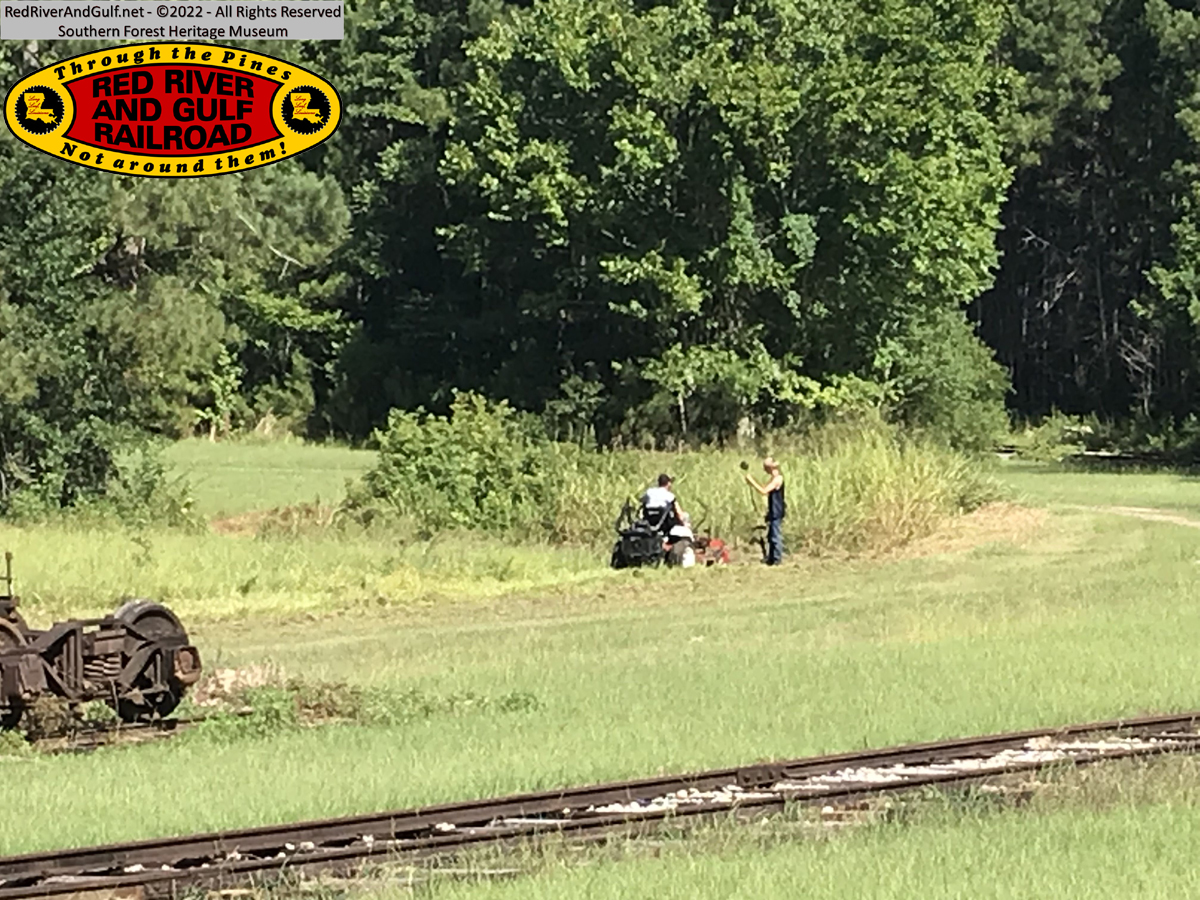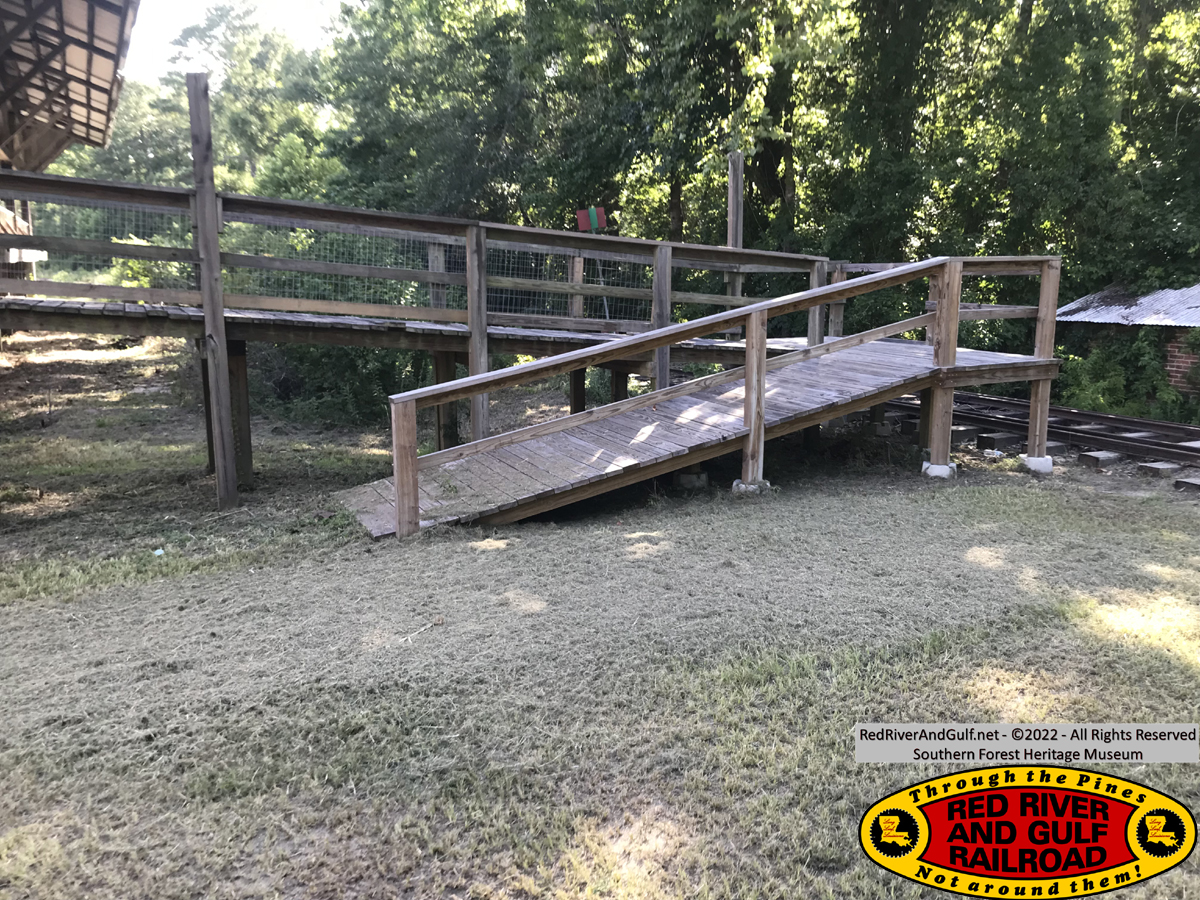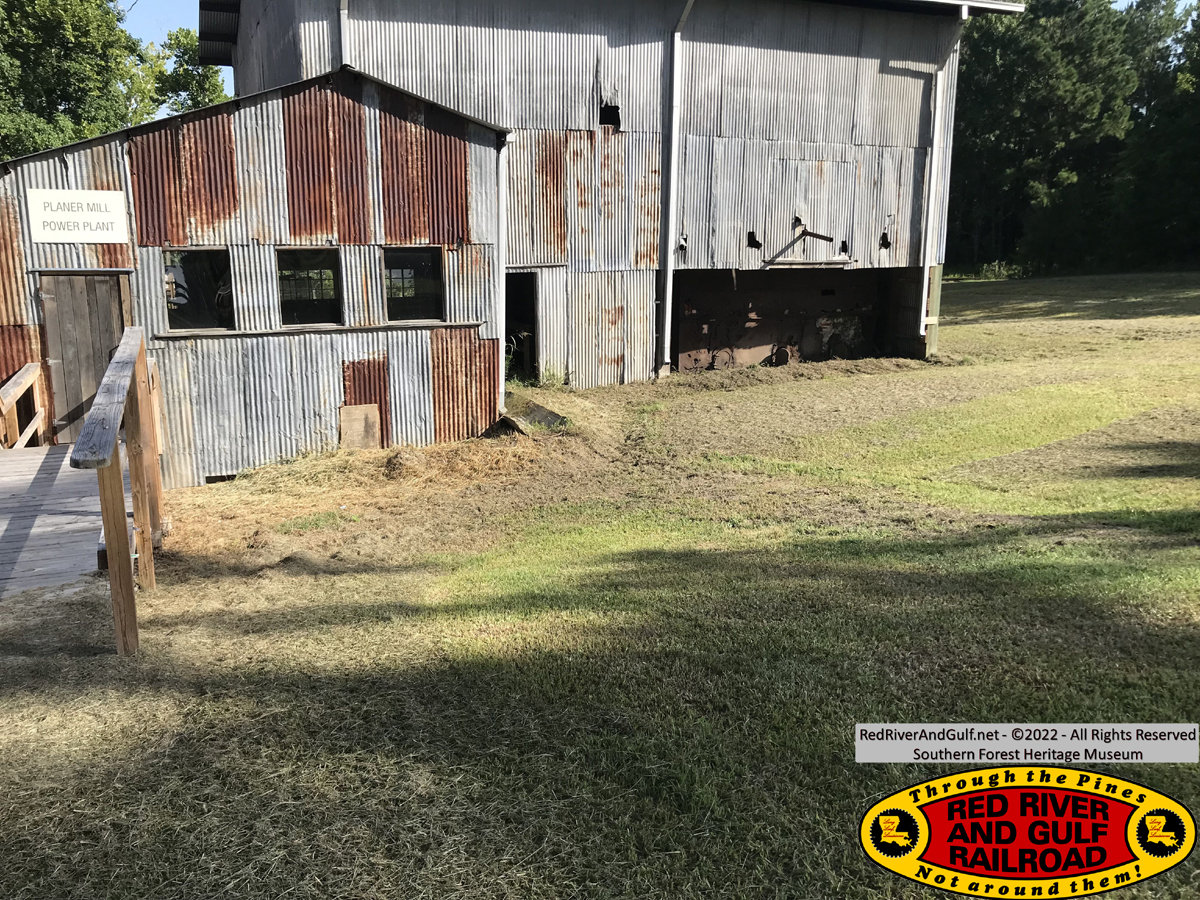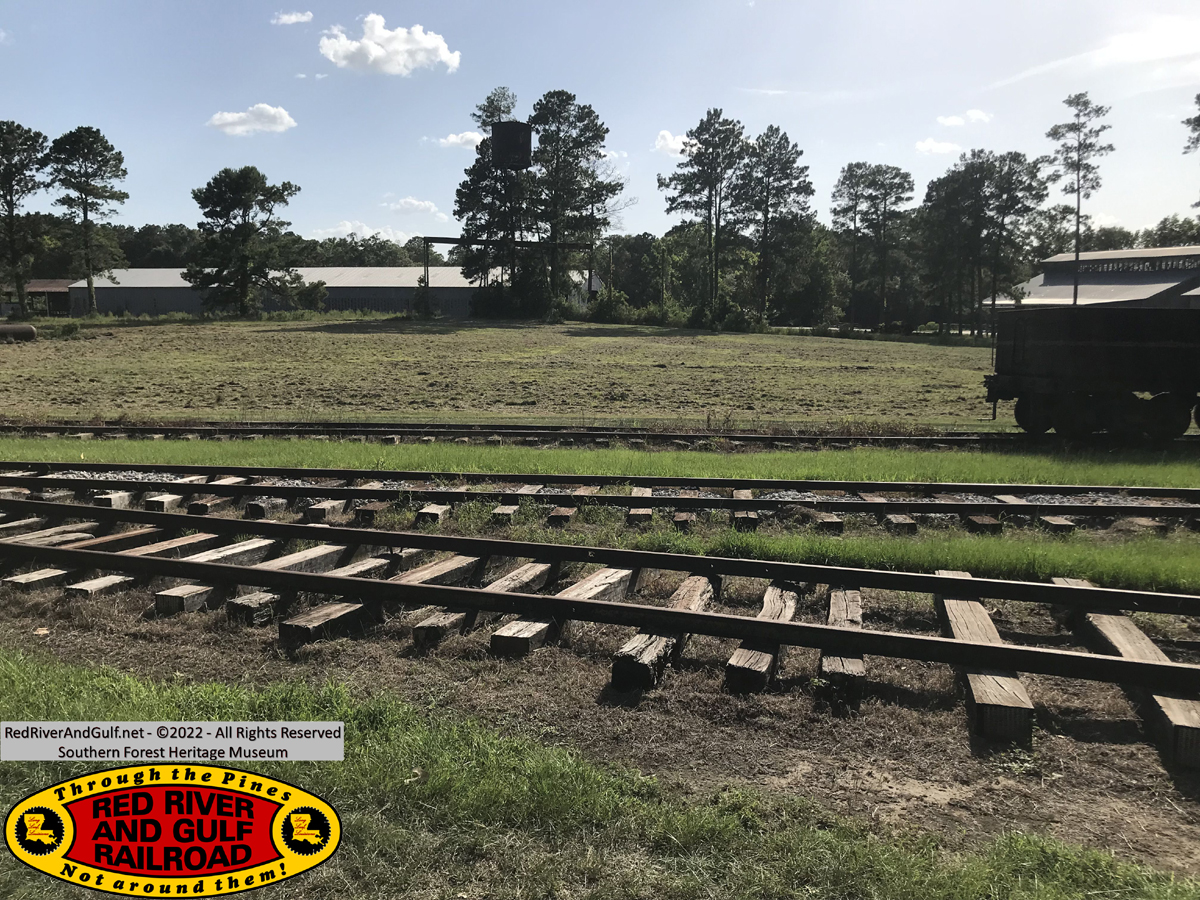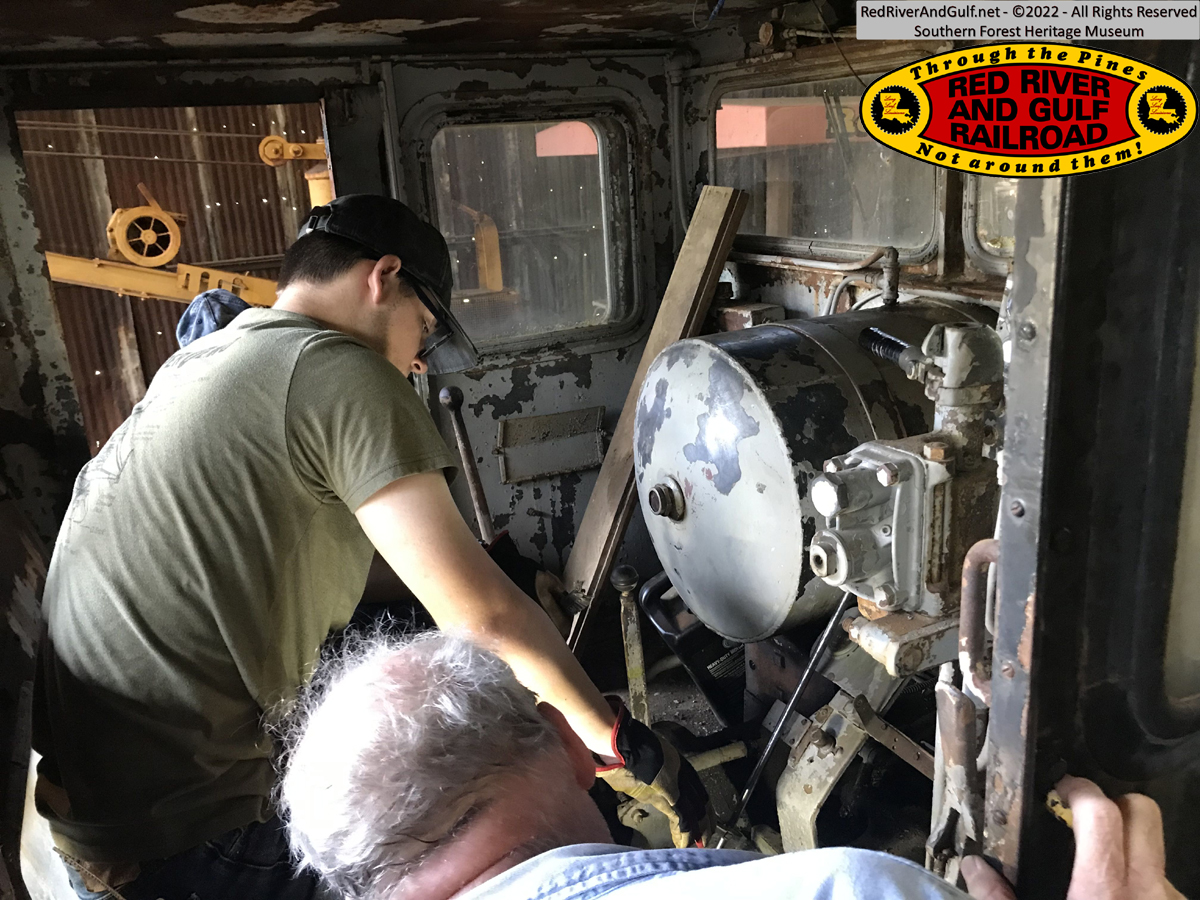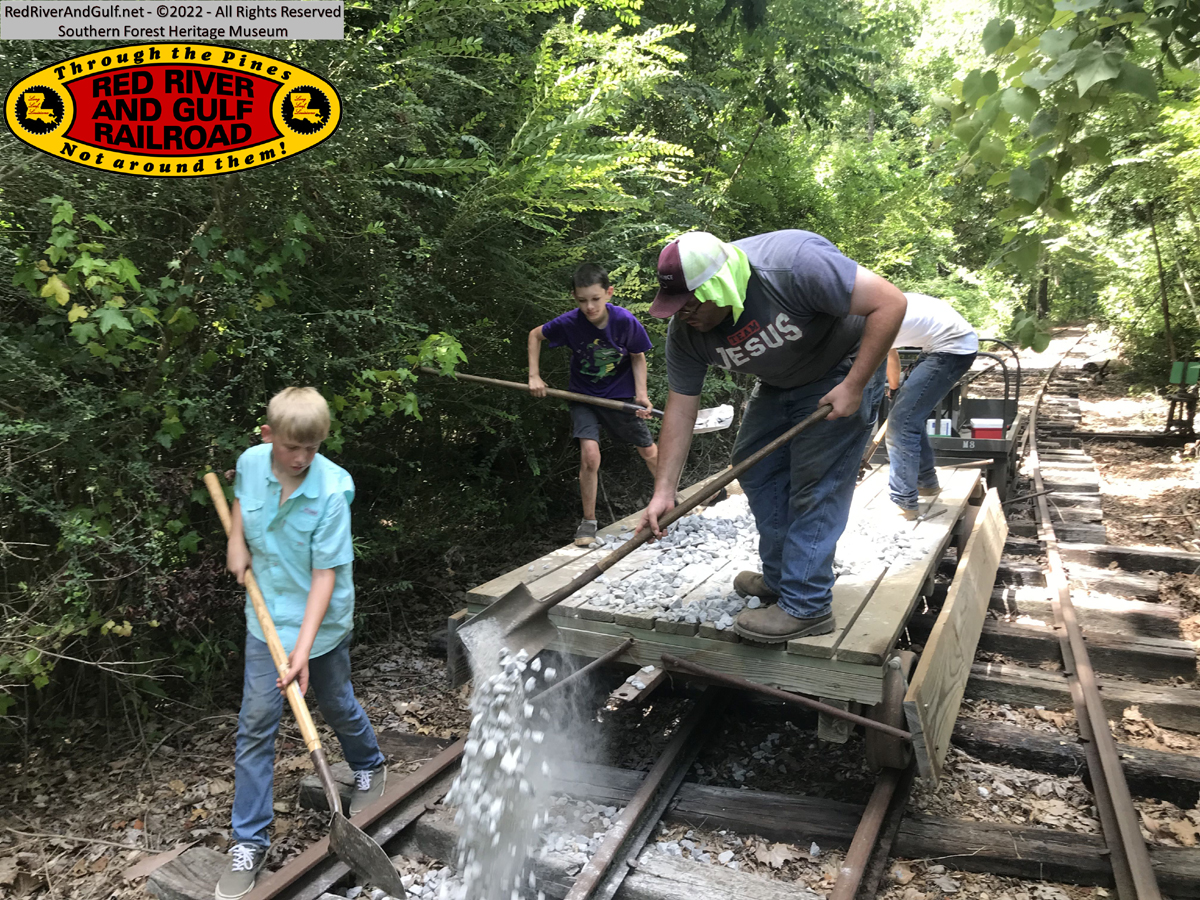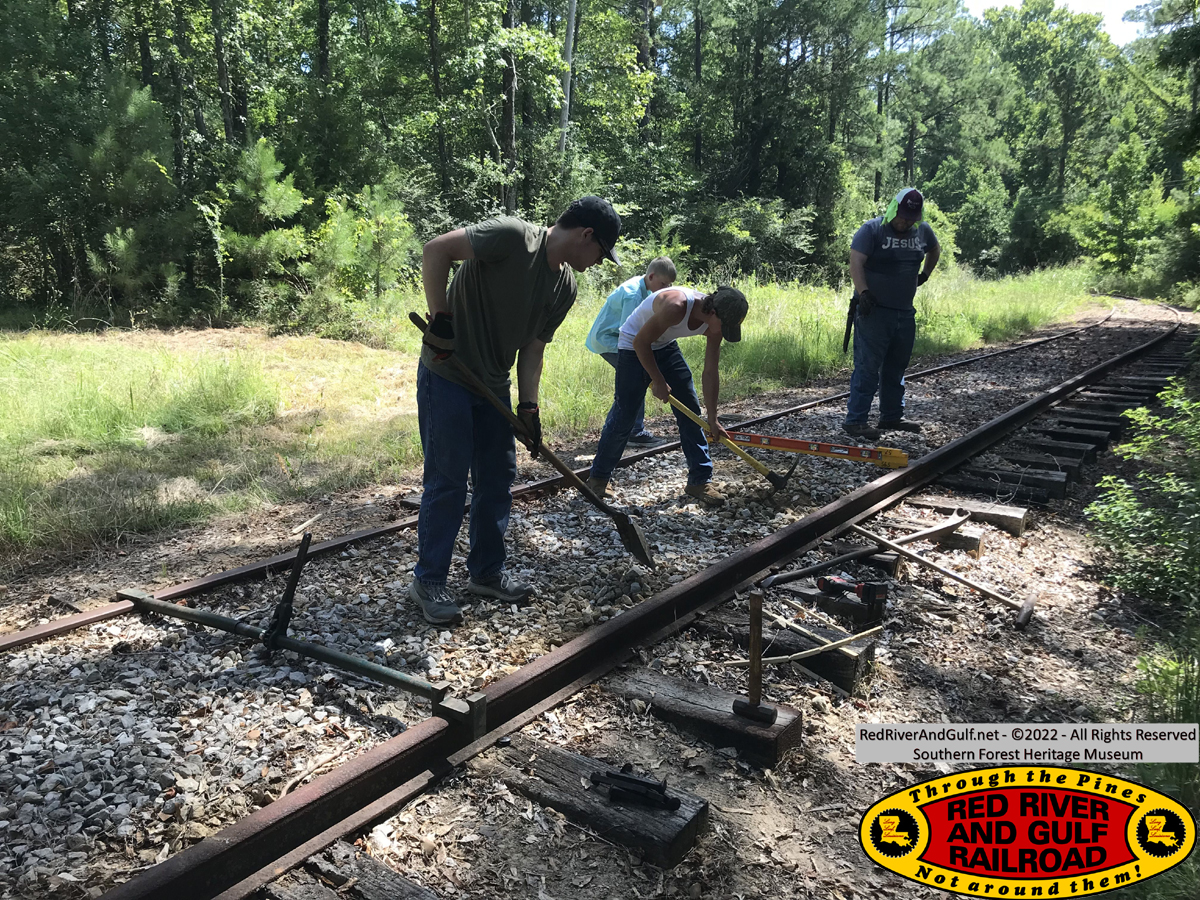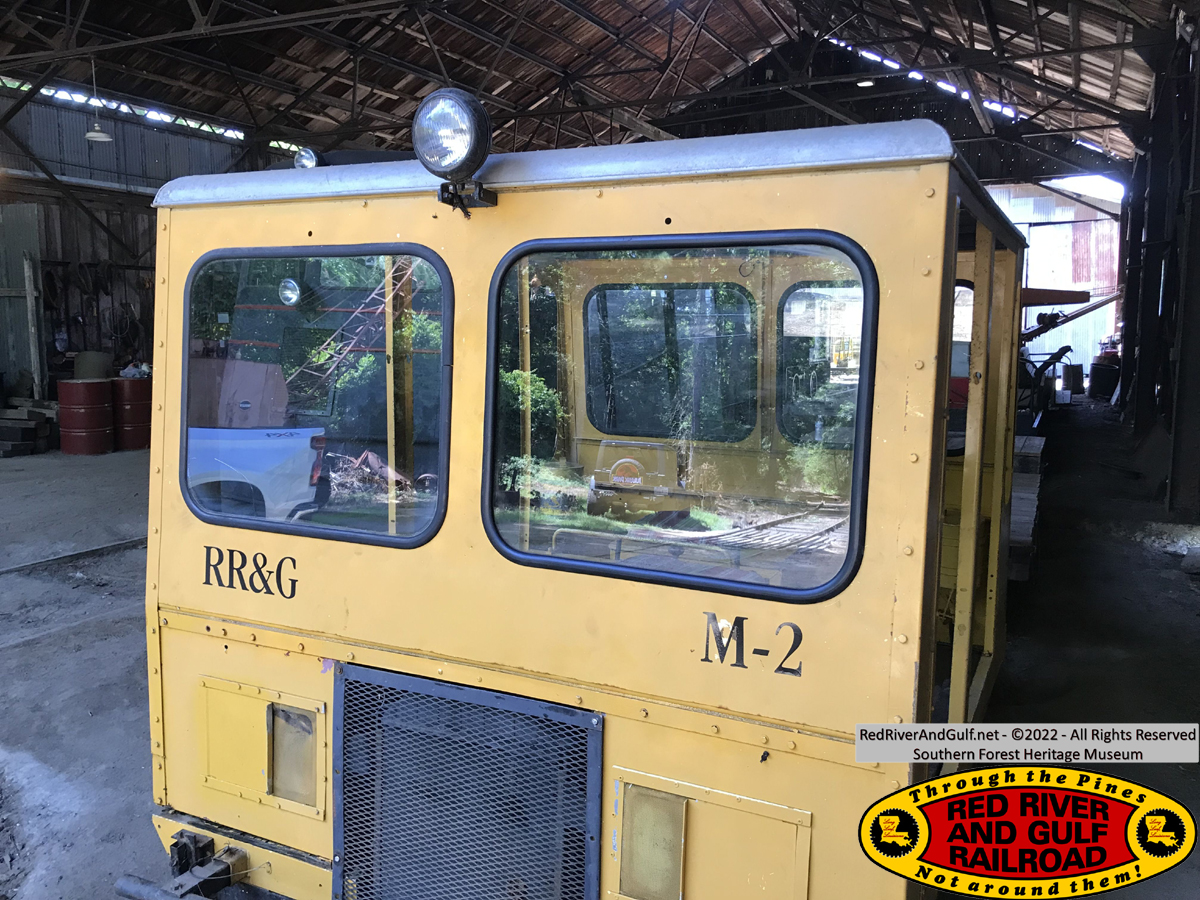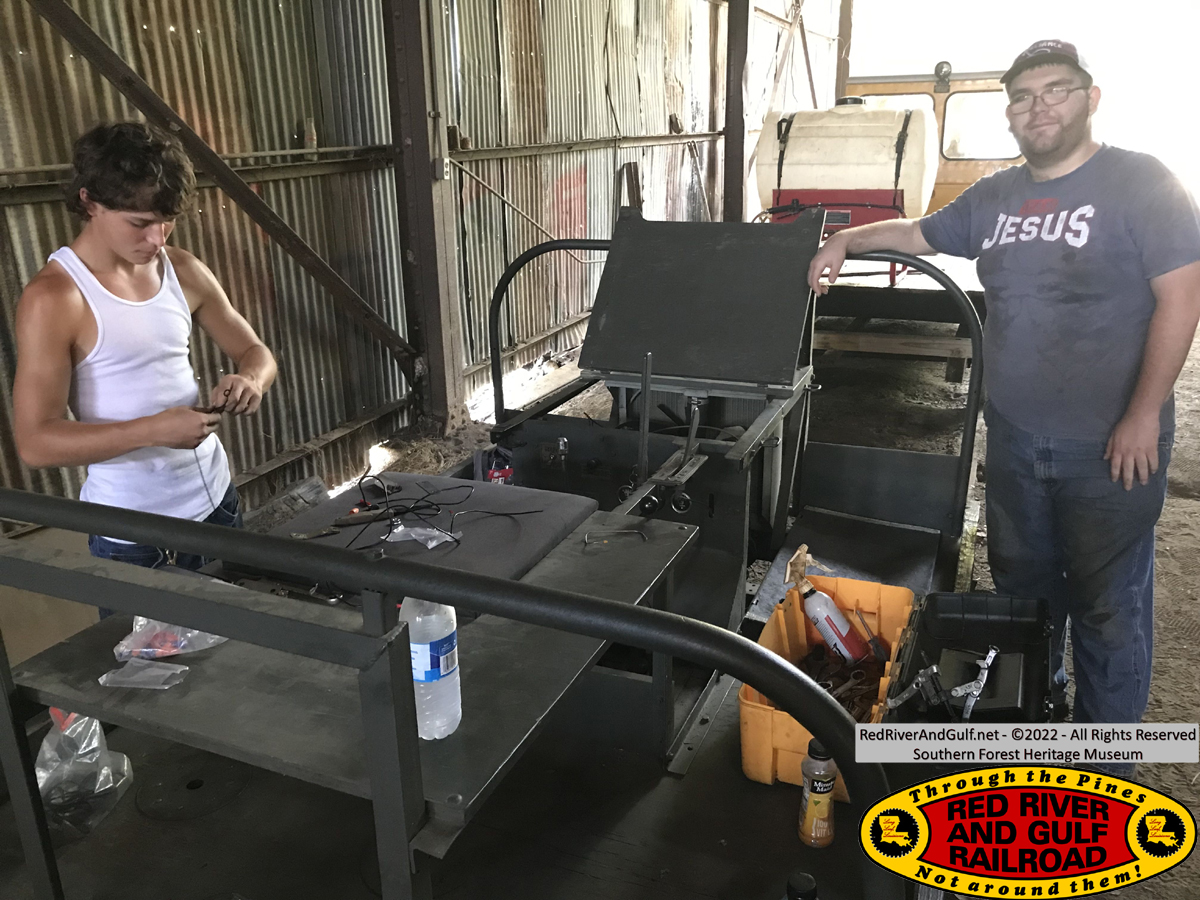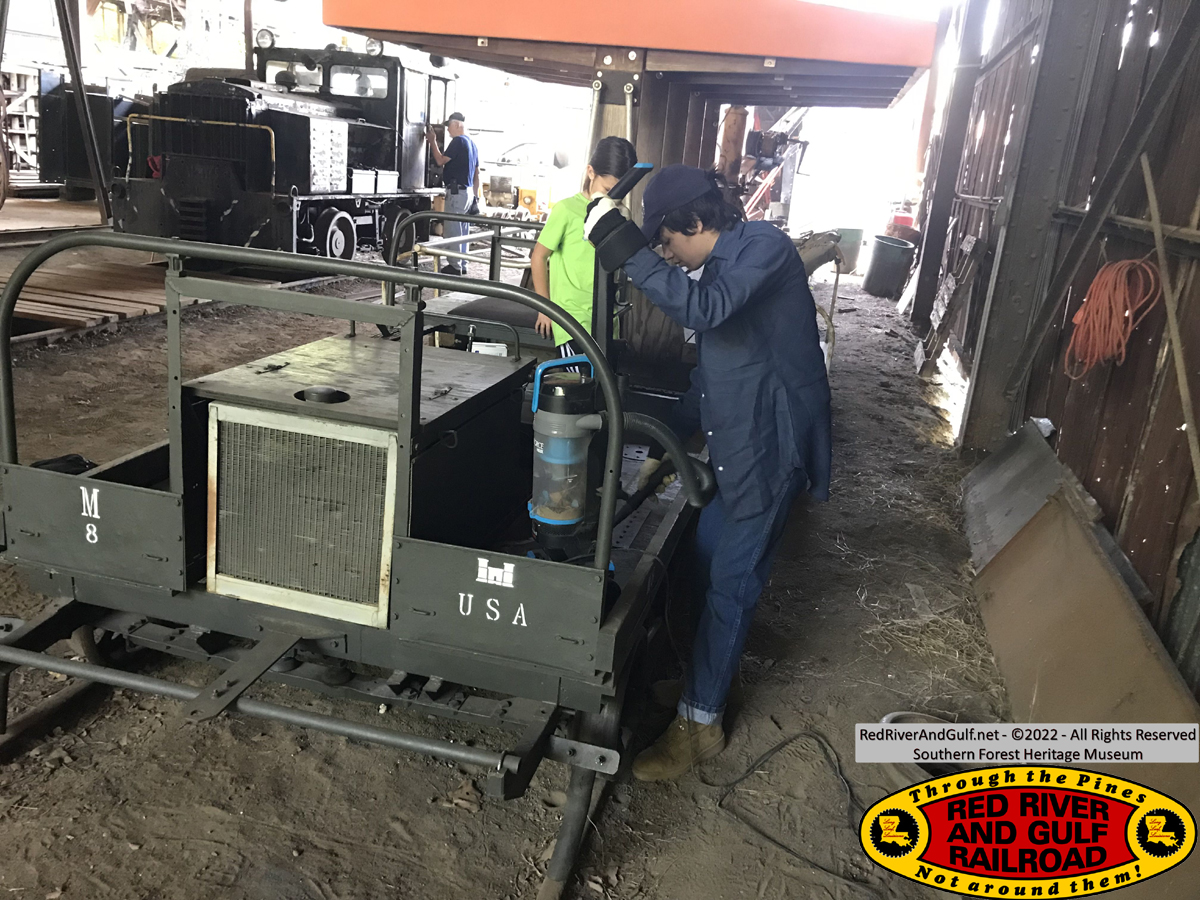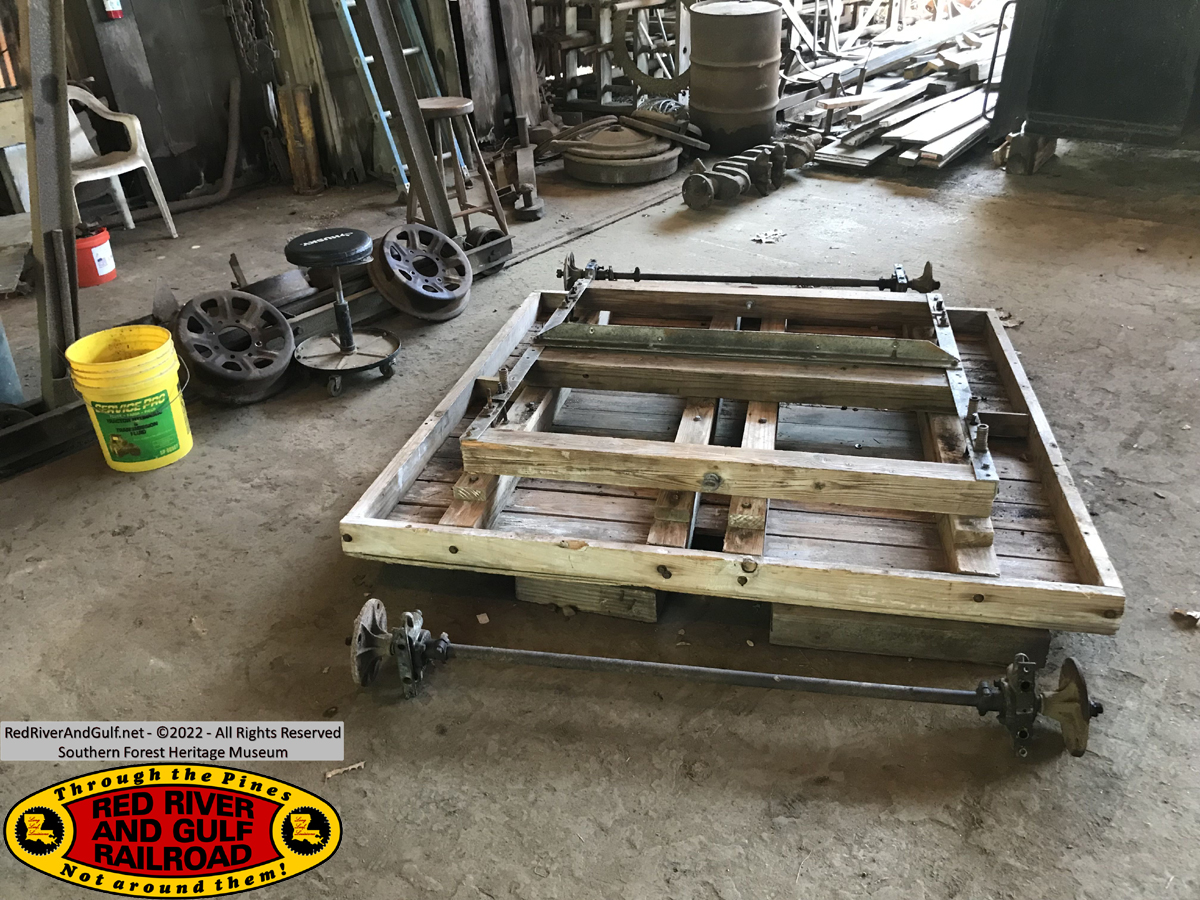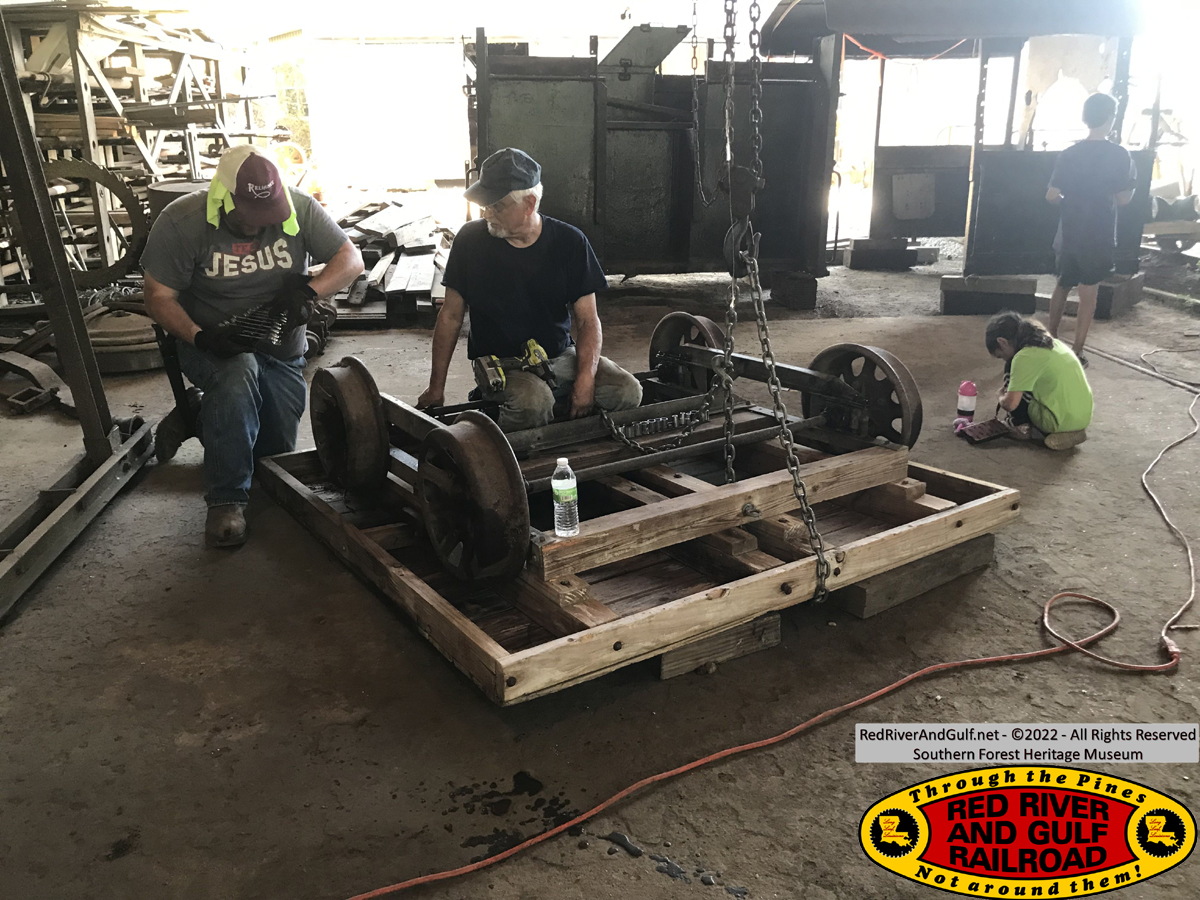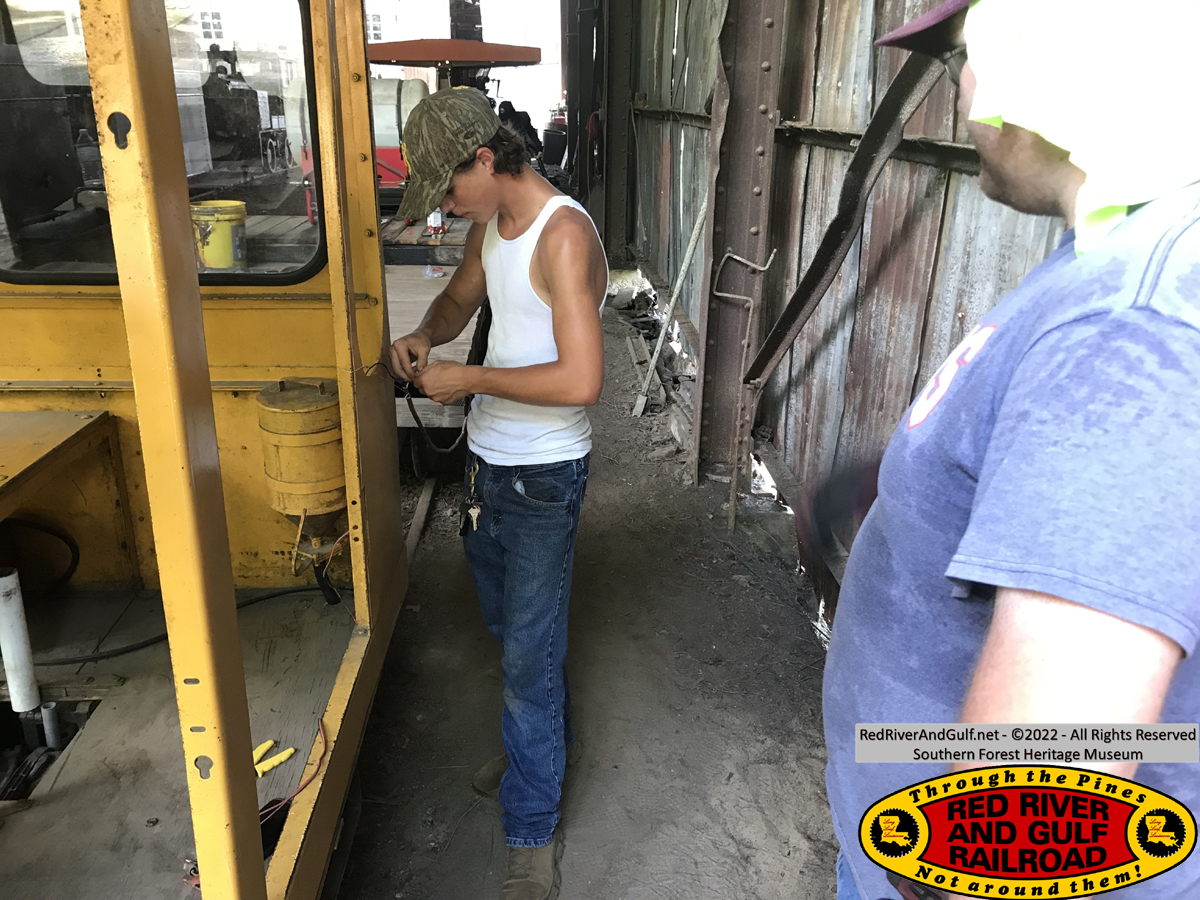|
Volunteer
Railroaders:
1. Everett L.
2. Mike M.
3. Mike B.
4. David H. Sr
5. Joseph S.
6. Gavin S.
7. Dwayne S.
8. Andrew A.
9. Angela A.
10. Clint L. Jr
11. Wimbley V.
12. Colton O.
13. Tucker B.
Accomplishments
1. M-22 locomotive cab thoroughly cleaned out, cab controls painted and
labeled
2. Instructional video of M-22 startup and operations recorded
3. M-22 speed control lever linkage lubricated
4. Replacement horn and horn pull cord installed on M-22
5. M-22 rusted-out headlight housings removed
6. Painted cab sides and cab doors of M-22
7. Continued development of an M-22 Operational Manual
8. Circular saw blades collected and moved to a good storage location
9. Bush-hogged remainder of tall vegetation in the main field
10. Mowed the main field portion that was bush-hogged at the prior
session (so the finished mower pulled by the tractor can be used over
the entire field)
11. Major vegetation cut back around the Planer Mill and Planer Mill
powerhouse
12. Herbicide sprayed over all trackage
13. 120 feet of track gauged and ballast leveled behind dry kilns
14. New glass windshield installed on M2 motorcar
15. Ballast dumped into small washout on mainline near car knocker lead
switch
16. New horns installed on M8 motorcar
17. Damaged flat car disassembled for repair
18. Repairs started on damaged flatcar
There was a great deal of good stuff going on this weekend! Thank you to
everyone who came out.
Before moving into the day-by-day recap of the weekend, there’s a few
recognitions to be shared. One is the shed behind the Commissary that
Mike Miller and the museum staff have recently repaired. A storm blew
the tin off the roof and not only has a new roof been installed, but
fresh lumber installed for the roof framing and good seals put in on the
windows. The structure is listed as a contributing structure in the
Crowell Sawmill Historic District and oral historical sources denominate
it as the Long Leaf gas station. Mike and the staff worked hard to
repair the structure to maintain its historic look and feel. Two, the
switch locks affixed to the switch stands are tremendously helpful to a
single person spraying herbicide. It keeps the switch lock always close
at hand for the switchman! An earlier volunteer weekend in April made
sure all switch stands had lockable handles, locks were inspected and
oiled, and switch stands were numbered. Three, Joseph S. has led the
charge to get much of the museum grounds “looking like a museum” in
anticipation of the upcoming Long Leaf Fall Festival. This has involved
many hours in the hot sun bush-hogging, mowing, weed eating, spraying
herbicide, cutting brush, and everything in between.
Friday
Mike Brown had come up earlier in the week and had been at work prepping
for a hydro test on the Heisler boiler. After the executive committee
meeting, Everett began work thoroughly cleaning out the cab of M-22.
Wielding a vacuum and scrapers, he was getting all the loose paint
chips, dust, dirt, and other material out of the cab. The cab is perhaps
the cleanest it has been in years. Tucker used the tractor to round up
the circular saw blades pulled out a stand of trees to get them out of
the grass for the mower. They were stacked up on a pallet and placed in
an appropriate storage space out of the way. These blades were pulled
out late last year to find a large one to use for a new museum sign on
Highway 497 that Glen is working on.
After finishing with the saw blades, Tucker mixed a herbicide batch and
began spraying the main loop and the wye tracks. During the spraying
run, however, the front wheels of M2 derailed at slow speed on the main
loop behind the old dry kiln. Mike Brown lent a hand to rerail the car
along with the museum tractor. After rerailing M2, the sprayer car
wouldn’t function. Before we headed back to the Engine House to
troubleshoot / repair the sprayer car, a full check-up of the track in
this area was conducted, checking the gauge, the ballast level, and all
other pertinent factors. The gauge was found to be tight and with
rerailing frogs in the rear of the car, extra weight on the back may
have contributed to the front end being lighter, and thus more easily
susceptible to being upset. The track in this area was repaired and
weight redistributed in M2 on Saturday.
Back at the Engine House, Mike Brown and Tucker began the
troubleshooting on the sprayer car electrical connections. Using his
voltage meter, Mike was able to rule out the on-off switch, the gator
clamps, and the air pump on the tank. Opening the splices revealed that
some of the wire connections needing cleaning and to be redone. The wire
splices were redone, and the sprayer came back to life. A big thank you
to Mike Brown for all his help Friday afternoon.
Saturday
The volunteers were working in many groups throughout Saturday and
accomplishing a variety of goals. To start the morning, Everett, David,
Clint, and Wimbley were continuing the cleanout of M-22’s cab with a
vacuum, cleaning out years of chipped-off paint. Wimbley used this
vacuum to give M2 and M8 a thorough cleaning as well. Dwayne did the
final repairs to the electrical lines for the sprayer car installing
butt connectors, splice covers, and taping up the splices while Andrew
and Tucker loaded up the sprayer car with track repair tools. The
rerailing frogs at the back of M2 were taken out and replaced with two
six-foot sticks of old rail placed near the side walls of M2. This was
to provide for better weight distribution in the car. With the tools
loaded up and a full tank of herbicide solution mixed up, a crew of
Wimbley, Clint, Andrew, Dwayne, Tucker, and Colton headed out to repair
the track behind the dry kilns and to finish spraying the main loop.
Mike Brown continued work on the Heisler. Joseph brought his zero-turn
lawnmower to cut the field portion he had bush hogged at a prior
session. Joseph’s goal was to cut the main vegetation down low enough so
that the museum lawnmowers or the finish tractor mower can be used on
the main field. The tall vegetation that had dominated the field, some
too tall to see over, needed to be bushhogged and then the base cut down
again to make mowing more manageable. Gavin started cutting vegetation
back around the railroad passenger ramp at the Planer Mill and around
the Planer Mill powerhouse.
The M-22 received a host of improvements this weekend, led by Everett
and David, with help from Angela and Clint. Everett listed these as
working on all the controls until they were all functioning smoothly,
managing the multiple control lines in the cab by grouping several
together with zip ties, lubricating the control lines so the locomotive
shuts off easily, installing a replacement horn, installing a horn pull
cord so it can be operated from the engineer’s seat, removing the
headlights as the wires were shorting out against the roof, lubricating
the throttle linkage, painting the cab sides and cab doors, labeling and
painting controls, and recording an instructional video on starting and
operating the locomotive. Everett is developing a detailed operations
manual with photos of the controls and oil dipstick locations.
Dwayne took the old horn to see if he could repair it. During the
following week (offsite), Dwayne reported to Tucker the horn has been
repaired and is working again. He’s working on polishing it and getting
it ready for use. Everett reached out to the Plymouth locomotive group,
especially the Kentucky Railway Museum as they have three Plymouth
locomotives, to get a photo or plans for the locomotive speed control
lever.
The locomotive headlight housings were completely rusted through, and
new housings will be needed to reinstall headlights. Next steps are to
lubricate the chain drive and grease the inner journal box fittings.
The track repair crew of Clint, Wimbley, Colton, Andrew, Dwayne, and
Tucker worked on 120 feet of track behind the dry kilns on the main
loop. Spikes were pulled and reset on approximately 40 crossties to have
this 120-foot stretch all in proper gauge as it was tight in spots.
Wooden spike-fillers were placed in the old spike holes, the rail
spreader was well utilized, and the track gauge was in almost constant
motion checking gauge. The ballast was leveled, and excess ballast was
cleared off the top of the ties and redistributed on the downward side
of the track for sediment control. Once finished, the crew cleaned up
the area, loaded up tools, and sprayed herbicide going back to the
Engine House. The consist rolled through the repaired area with no
issues, not even a flange squeal was heard, according to my
recollection.
After lunch, the volunteers again split again into crews and re-group
throughout the afternoon. Joseph bushhogged the final portion of the
main field not cut at the prior volunteer weekend and mowed around the
Planer Mill and Planer Mill powerhouse. Gavin continued to cut back as
much vegetation as possible way from the Planer Mill structure. They did
a remarkable job this weekend and are well commended! A good follow-up
to make this effort go further is to spray herbicide in the cutover
areas.
Everett, David, and Angela continued work on the M-22 locomotive while
the morning track repair crew split into two groups. Clint and Wimbley
sprayed the wye tracks, the car knocker shed lead track, and the line to
Sandersville with herbicide. They also used the sprayer wand to cover a
wide swath of vegetation around the Engine House lead tracks with
herbicide. Dwayne, Andrew, and Tucker unloaded the lumber from the
drop-side flatcar (known as the “Horseman,” as the track crane is called
“Ichabod”) that had been used in prior projects. After some switching
with M8, Tucker brought in a tractor bucket-load of gravel and dumped it
into the drop-side flatcar pulled by M8. Andrew, Tucker, Dwayne, and
Colton then shoveled this ballast into the small washout on the main
line track near the switch for the car knocker shed lead. This washout
was no longer growing after Mike Miller and Tucker had removed a huge
tire blocking the drain culvert some time ago.
During the ballast fill-in operation, Mike Miller, Mike Brown, Wimbley,
and Clint were attempting to install the new windshield and gasket for
M2 that Tucker procured from Red River Glass in Alexandria. Red River
Glass had used the old, cracked windshield as a guide and was able to
reproduce a new one in the exact dimensions needed. It is two pieces of
safety glass laminated together to a middle sheet of clear material.
Unfortunately, the windshield just wouldn’t go in right, and the
windshield and gasket were set aside for studying for the next install.
We would soon try again to get the new windshield installed.
Ending the day, the volunteers returned the track tools to the tool room
and cooled down from the day at the Engine House. David and Dwayne
checked the electrical lines on M8 to find out why the horn wasn’t
working. The horn itself was found to be bad and Wimbley took it home.
He and Glen completed the M8 restoration, including getting the horn
brand new. Perhaps they would think it’s time for a refund on the horn….
Several folks continued to lend a hand with the M-22 work while Andrew
and Gavin began disassembly of the damaged flatcar. We were taking apart
the wheels, axles, hubs, and bearing houses so Mike Miller could begin
the necessary repairs on all these parts. We’ll also make some general
improvements to the car as well.
Sunday
On Sunday, Dwayne and Andrew installed the two new horns picked up the
night before on M8. With the master disconnect turned on, the new horns
sounded bright and clear! The horn is now functional again on M8.
Everett and Angela continued work in the M-22 cab, painting controls,
making labels, and recording an instructional video. Joseph, Gavin,
Andrew, Dwayne, and Tucker, with help from Everett, finished taking
apart the damaged flatcar. Some bolts came off the normal way while some
had to be cut off. Mike Miller came by the museum later that afternoon
and began the repair work, starting first with the bearings and their
housing.
Everett got a mildew cleaning solution Saturday night and gave a
thorough cleaning of the handcar, the inside of M2, and the outside of
M2. Everett and Joseph then successfully installed the new windshield on
M2 using a putty knife and a wood carving tool. With some Windex, the
windshield on M2 looked pristine!
One of the benefits of volunteering at Long Leaf is the discovery
opportunities, both for physical items and in historical understanding.
Andrew, Joseph, and Dwayne, during their looking-around the area north
of the Engine House, found an intact switch frog only a few feet away
from the car knocker shed lead track, tucked behind a large pile of
boiler flue tubes. None of us had ever seen this one before due the all
the brush that had been in this area. Everett shared some history was we
cooled off in the Engine House shade with a slight breeze.
Thank you for everyone who volunteered this weekend. We hope to see you
again soon at Long Leaf.
-Tucker "Who Dat" Baker
RR&G Road Master
|
